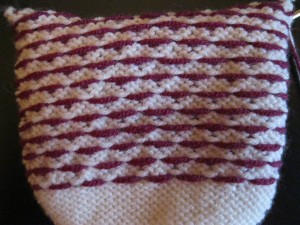Welcome back to sock knitting with the Progressive Needles KAL! This month’s project brings us two-color knitting in a toe up sock using the lovely hues of Royal by Austermann. I am a huge fan of color work and after knitting this pattern you will be, too!
Disappearing Act begins with simple toe up construction. If you are new to toe up socks, watch my #1 video, “Judy’s Magic Cast On”. Before starting, you will need to decide which color to designate as Color A – the toe color. There is NO right or wrong choice. For my sample, I chose the light color as Color A and the dark color as Color B. My dozens of test knitters chose a multitude of color combinations and they were all equally fabulous.
Upon completion of the toe, this week’s clue continues with the beginning of the color work pattern. Disappearing Act is a stranded knitting color pattern. Stranded knitting, often referred to as Fair-Isle knitting, is a technique generally worked in stockinette with no more than two colors in a row. I have created a clever yet simple pattern to introduce you to the wide range of design possibilities.
Disappearing Act is available in three sizes – Small, Medium and Large. Stranded knitting requires more yarn than single color stockinette. This pattern allows for an interesting play of color well within the yardage limit of two 50 gram skeins. The finished length of the sock, measured from the tip of the toe and up the front of the foot/leg to the cuff, is determined by the number of stitches in each round. (See Size info below.) A Small sock has fewer stitches per round allowing for more repeats of the design within the yardage. A Large sock has more stitches per round allowing for less repeats of the design within the yardage. I wanted to provide you with a pattern that introduced you to stranded knitting while using a frugal amount of yarn. If you prefer a longer sock, more yardage will be needed.
Stranded knitting is executed with the yarns held in one hand or two. For One-Handed stranding, knit with one color to the color change. Drop the working yarn and bring the new color over the top of the dropped yarn. Continue knitting to the next color change and repeat the process.
Like traditional European knitters, I prefer to work stranded knitting with the Two-Handed method. This method combines the Continental and Western styles of knitting. The left hand holds one color of yarn to be “picked” while the right hand throws the other color of yarn. As a lifelong Western-style knitter (thrower), this was groundbreaking stuff! I was pleasantly surprised how speedy I became at this combined method after just a few rounds. Watch my “Two Handed Two Color Knitting” Video to take your knitting to the next level. I strongly encourage you to try this slick technique.
The challenge in stranded knitting is to maintain an even tension as you alternate between the two colors. The strands across the wrong side of the fabric mustn’t be too tight or it will cause the fabric to pucker. Conversely, if the strands are too loose it will leave large loops on the wrong side that may snag when wearing. An even tension leaves the strands on the wrong side (as seen below) laying gently over the stitches providing an extra layer of warmth. A bit of practice will have your tension even and smooth.
Stranded knitting leaves a firm fabric with little stretch. To accommodate this characteristic, the stitch count is increased after the toe prior to the color work. I highly recommend inserting a Lifeline after the toe. Upon completion of Section I, measure the width of your sock and evaluate its size compared to your foot. Should you need to change the size or adjust the needles, it becomes quite easy to take your work back to the lifeline at the toe. See my “Lifelines” Video to learn this essential knitting skill.
Lastly, changing needles sizes is very common among stranded knitters AND sock knitters. One size may work for the toe and/or foot while a larger size may give the needed room for the leg. Experiment, measure and implement a lifeline for a successful fit!
Part One
Click here to download printable version
![]()
One skein Royal by Austermann, 50g / 219 yards, (Color A)
One skein Royal by Austermann, 50g / 219 yards, in a contrasting color (Color B)
US#1 (2.5mm) needles or size necessary to achieve desired gauge. Pattern may be knit with double points, two circular knitting method or magic loop. See “Magic Loop” Video
8.5 stitches = 1 inch in stockinette.
Women’s Small, Medium and Large. Additional size adjustments may be made by altering needle sizes.
Small leg circumference measures approximately 7” unstretched and stretches comfortably to 10”. Finished length measured along top of foot from toe to cuff is 13½”.
Medium leg circumference measures approximately 7¾” unstretched and stretches comfortably to 11”. Finished length measured along top of foot from toe to cuff is 12½”.
Large leg circumference measures approximately 8½” unstretched and stretches comfortably to 12½”. Finished length measured along top of foot from toe to cuff is 11½”.
A – Color A
B – Color B (contrasting color)
kfb – knit into front and back of stitch. See “kfb” Video
Note: Directions are for Small Size (Medium, Large Size in parentheses when necessary). When knitting from patterns with multiple sizes, use a highlighter to mark the numbers that pertain to your size.
TOE
Cast On – See “Judy’s Magic Cast On” Video
With Color A and using two needles, cast on 20(24,24) stitches using Judy’s Magic Cast On with 10(12,12) stitches on each needle.
Securing tail, knit first 10(12,12) stitches.
Knit second 10(12,12) stitches through the back loop.
Toe Increases
If using one or two circular needle knitting method, increases (kfb) are made at the beginning and end of each needle as follows:
Round 1. On 1st needle, kfb, knit to last stitch on needle, kfb;
On 2nd needle, kfb, knit to last stitch on needle, kfb.
Round 2. Knit all stitches.
If using double points, arrange stitches evenly with 5(6,6) stitches on 4 needles. Increases (kfb) are made as follows:
Round 1. Kfb, knit to last stitch on 2nd needle, kfb, kfb into 1st stitch on 3rd needle, knit to last stitch on 4th needle, kfb.
Round 2. Knit all stitches.
All needle types: Repeat Rounds 1 and 2 until toe reaches 56(64,72) stitches.
*I recommend placing a lifeline after the toe to allow for easy changes in size if needed. See “Lifelines” Video
FOOT
Increase 8 stitches evenly in next round as follows: *K6(7,8), kfb; repeat from * to end of round. 64(72,80) stitches
Knit remainder of sock following Two-Color Pattern beginning with Section I, found below. Work this section the recommended number of repeats.
ALL stitches are worked in the knit stitch. See “Two Handed Two Color Knitting” Video
Two-Color Pattern
Section I – Work these 4 rounds 8(7,6) times. A total of 32(28,24) rounds.
Round 1. *3A, 1B; repeat from * to end of round.
Round 2. Knit A.
Round 3. 1A, 1B, *3A, 1B; repeat from * to last 2 stitches, 2A.
Round 4. Knit A.
STOP!
Take the time to ensure that the sock provides a good fit. If needed, take knitting back to the lifeline and reknit making a different size or changing needle sizes.
Happy knitting!



